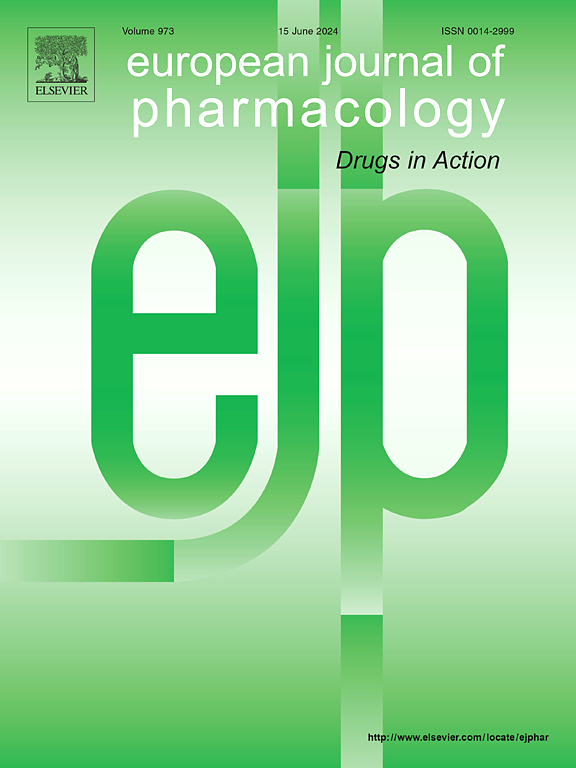蛋白激酶 C(PKC)抑制剂钙泊三嗪 C 在高浓度下通过产生单线态氧以光依赖的方式激活 PKC。
IF 4.2
3区 医学
Q1 PHARMACOLOGY & PHARMACY
引用次数: 0
摘要
Calphostin C(Cal-C)是一种蛋白激酶 C(PKC)抑制剂,能与其 C1 结构域结合。本研究的目的是阐明 Cal-C 除了抑制 PKC 之外的作用。首先,我们证实低浓度(< 200 nM)的 Cal-C 可抑制薄荷醇酯诱导的 PKC 转位和 G 蛋白偶联受体(GPCR)介导的 PKC 激活。较高浓度(> 2 μM)的 Cal-C 能以浓度依赖的方式增加细胞内钙离子浓度([Ca2+]i)。钙离子浓度增加的原因是内质网(ER)的动员,与 GPCR 或雷诺丁受体无关。高浓度的 Cal-C 还会导致 ER 结构发生变化,如形成空泡和聚集体,以及钙从 ER 泄漏。在 2 μM 的浓度下,Cal-C 会转移对钙敏感的 PKCα。使用 C 激酶活性报告器和融合了绿色荧光蛋白(GFP)的肉豆蔻酰化富丙氨酸蛋白激酶 C 底物进行的研究也显示,高浓度的 Cal-C 能激活活细胞中的 PKC。此外,Cal-C 的 PKC 激活效应还与光有关。最后,使用单线态氧指示剂 Si-DMA 进行的研究表明,高浓度 Cal-C 会产生单线态氧,导致 ER 结构发生变化,钙渗漏到细胞质中,从而引发 PKC 激活。这项研究证实了仅被视为 PKC 抑制剂的 Cal-C 的新作用。低浓度的Cal-C是PKC抑制剂,而高浓度的Cal-C则是PKC激活剂,它以光依赖的方式产生单线态氧,这表明Cal-C可用于光动力疗法。本文章由计算机程序翻译,如有差异,请以英文原文为准。
Protein kinase C (PKC) inhibitor Calphostin C activates PKC in a light-dependent manner at high concentrations via the production of singlet oxygen
Calphostin C (Cal-C) is a protein kinase C (PKC) inhibitor that binds to its C1 domain. The aim of the present study was to elucidate the action of Cal-C in addition to PKC inhibition. First, we confirmed that Cal-C at low concentrations (<200 nM) inhibit phorbol ester-induced PKC translocation and G-protein-coupled receptor (GPCR)-mediated PKC activation. Cal-C at higher concentrations (>2 μM) increased intracellular calcium ion concentrations ([Ca2+]i) in a concentration-dependent manner. The origin of this increase is the mobilization of the endoplasmic reticulum (ER), which does not involve GPCR or ryanodine receptors. Cal-C at high concentrations also cause structural changes in the ER, such as the formation of vacuoles and aggregates, and calcium leakage from the ER. At 2 μM, Cal-C translocated a calcium-sensitive PKCα. Studies using a C-kinase activity reporter and a myristoylated alanine-rich protein kinase C substrate fused with green fluorescent protein (GFP) have also revealed that Cal-C at high concentrations activate PKC in living cells. Additionally, the PKC-activating effects of Cal-C were light-dependent. Finally, studies using Si-DMA, an indicator of singlet oxygen, showed that Cal-C at high concentrations generated singlet oxygen, causing structural changes in the ER and leakage of calcium into the cytosol, which triggered PKC activation. This study confirms the novel action of Cal-C, solely considered a PKC inhibitor. Cal-C acted as a PKC inhibitor at low concentrations and a PKC activator at high concentrations by generating singlet oxygen in a light-dependent manner, suggesting that Cal-C can be used in photodynamic therapy.
求助全文
通过发布文献求助,成功后即可免费获取论文全文。
去求助
来源期刊
CiteScore
9.00
自引率
0.00%
发文量
572
审稿时长
34 days
期刊介绍:
The European Journal of Pharmacology publishes research papers covering all aspects of experimental pharmacology with focus on the mechanism of action of structurally identified compounds affecting biological systems.
The scope includes:
Behavioural pharmacology
Neuropharmacology and analgesia
Cardiovascular pharmacology
Pulmonary, gastrointestinal and urogenital pharmacology
Endocrine pharmacology
Immunopharmacology and inflammation
Molecular and cellular pharmacology
Regenerative pharmacology
Biologicals and biotherapeutics
Translational pharmacology
Nutriceutical pharmacology.

 求助内容:
求助内容: 应助结果提醒方式:
应助结果提醒方式:


